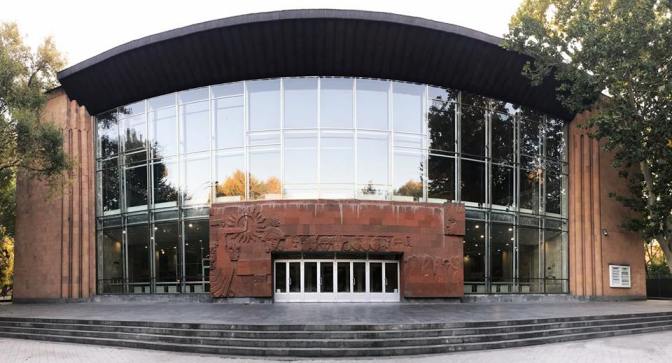Yerevan inherited a gallery of state-owned theaters from Soviet times. The Sundukian National Academic Theater started its 100th theatrical season in September 2021.
The National Academic Theater was founded in Yerevan in 1921 with the name of First State Theater of Armenia. It opened its doors on January 25, 1922 with the performance of Gabriel Sundukian’s (1825-1912) classic play “Pepo.” Until 1938 it functioned at the worker’s club named after Stepan Shahumian (in the place of today’s Marriott-Armenia Hotel), and then was moved to the newly built building in the Park of the Communards, later renamed the 26 Commissars Park, which recovered its pre-Soviet name of English Park after the independence.
The first artistic director of the Theater was Levon Kalantar. The initial group was formed by some of the finest names of Armenian theater at the time: actors like Vahram Papazian, Hrachia Nersisian, Vagharsh Vagharshian, Gurgen Janibekian, etcetera, and actresses like Hasmik (Taguhi Hakobian), Olga Gulazian, Arus Voskanian, and others. The repertoire of the theater in the 1920s included works like “Bandits” (Friedrich Schiller), “The Government Inspector” (Nikolai Gogol), “Brother Balthazar” (Hagop Baronian), “Khatabala” (G. Sundukian), and others.
Armen Gulakian and Arshak Burjalian took the artistic direction of the theater between 1930 and 1953. In 1937 the theater was renamed after Gabriel Sundukian. During World War II (called the Great Patriotic War in Soviet nomenclature), patriotic literature enjoyed a brief period of freedom under the Stalinist regime, and the repertoire presented many plays with such themes, like Nayiri Zarian’s “Revenge,” Muratsan’s “Gevorg Marzpetuni,” and others.
In the 1950s, works like “Othello” (William Shakespeare), “Masquerade” (Mikhail Lermontov), “Trial Field” (N. Zarian), “Brother Balthazar” (H. Baronian), among others, showcased the talents of luminaries like Papazian and Nersesian, as well as other actors like Janibekian, Avet Avetisian, Tatik Sarian, and others. The staging of Alexander Shirvanzade’s “Honor” revealed the names of the next generation of Armenian actors and actresses who would take over the theatrical heritage: Metaksia Simonian, Khoren Abrahamian, Sos Sargisian, Mher Mkrtchian, and others.
In the period 1953-1977, under the artistic direction of Vardan Achemian, the Sundukian Theater rose to new heights. Among the best productions was William Saroyan’s “My Heart Is in the Mountains,” Alexander Sukhovo-Kobilyn’s “Judicial Case,” Aramashot Babayan’s “Yes, the World Has Turned Upside Down,” Zarzand Darian’s “The President of the Republic,” etcetera. The Sundukian Theater was recognized as an academic theater in 1960 and its building was rebuilt in 1966. After his death, Achemian was succeeded by Hrachia Ghaplanian (1977-1979, 1985-1988) and Khoren Abrahamian (1979-1984, 1988-1993) as artistic directors. In the 1960s-1980s, the theater made various tours abroad (Lebanon, Syria, France, Bulgaria, Norway, the United States, Turkey, etcetera). After independence, the Sundukian Theater has continued its activities, renovating its repertoire according to the new atmosphere of artistic freedom. Since 2015, Armen Elbakian has been its artistic director.

